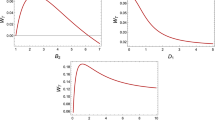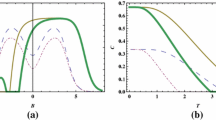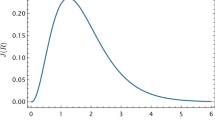Abstract
We study the thermal entanglement between three qubits in a N-qubits isotropic spin \(\frac{1}{2}\) Heisenberg XXX chain, using the lower bound of concurrence. In particular, we show the dependence of the tripartite entanglement in terms of the magnetic field, temperature, the number of sites N in the chain and the lattice spacing between every three qubits. A N-qubit quantum heat engine is then constructed based on this multiqubit Heisenberg spin \(\frac{1}{2}\) XXX model, and the variation of different thermodynamic quantities (efficiency, work and heat released and absorbed) is studied with respect to the tripartite thermal entanglement in zero and nonzero magnetic field, as well as for odd and even N chains. The conditions for which the second law of thermodynamics is always preserved are established.









Similar content being viewed by others
Data availability
The datasets generated during and/or analysed during the current study are available from the corresponding author on reasonable request.
References
Schrödinger, E.: Discussion of probability relations between separated systems. In: Mathematical Proceedings of the Cambridge Philosophical Society, vol. 31, pp. 555–563. Cambridge University Press (1935)
Murao, M., Jonathan, D., Plenio, M.B., Vedral, V.: Quantum telecloning and multiparticle entanglement. Phys. Rev. A 59(1), 156 (1999)
Nielsen, M.A., Chuang, I:. Quantum computation and quantum information (2002)
Arnesen, M.C., Bose, S., Vedral, V.: Natural thermal and magnetic entanglement in the 1d Heisenberg model. Phys. Rev. Lett. 87(1), 017901 (2001)
Wang, Xiaoguang: Entanglement in the quantum Heisenberg xy model. Phys. Rev. A 64(1), 012313 (2001)
Kamta, G.L., Starace, A.F.: Anisotropy and magnetic field effects on the entanglement of a two qubit Heisenberg xy chain. Phys. Rev. Lett. 88(10), 107901 (2002)
Sun, Yang, Chen, Yuguang, Chen, Hong: Thermal entanglement in the two-qubit Heisenberg xy model under a nonuniform external magnetic field. Phys. Rev. A 68(4), 044301 (2003)
Wang, X., Fu, H., Solomon, A.I.: Thermal entanglement in three-qubit Heisenberg models. J. Phys. A Math. General 34(50), 11307 (2001)
Wang, Xiaoguang, Zanardi, Paolo: Quantum entanglement and bell inequalities in Heisenberg spin chains. Phys. Lett. A 301(1–2), 1–6 (2002)
Coffman, V., Kundu, J., Wootters, W.K.: Distributed entanglement. Phys. Rev. A 61(5), 052306 (2000)
Mintert, Florian, Kuś, Marek, Buchleitner, Andreas: Concurrence of mixed bipartite quantum states in arbitrary dimensions. Phys. Rev. Lett. 92(16), 167902 (2004)
Li, Ming, Fei, Shao-Ming., Wang, Zhi-Xi.: A lower bound of concurrence for multipartite quantum states. J. Phys. A: Math. Theor. 42(14), 145303 (2009)
Abaach, Sanaa, Faqir, Mustapha, El Baz, Morad: Long-range entanglement in quantum dots with Fermi-Hubbard physics. Phys. Rev. A 106, 022421 (2022)
Geva, E., Kosloff, R.: A quantum-mechanical heat engine operating in finite time. A model consisting of spin-1/2 systems as the working fluid. J. Chem. Phys. 96(4), 3054–3067 (1992)
He, Jizhou, Chen, Jincan, Hua, Ben: Quantum refrigeration cycles using spin-1 2 systems as the working substance. Phys. Rev. E 65(3), 036145 (2002)
Feng, Wu., Chen, Lingen, Sun, Fengrui, Chih, Wu., Li, Qing: Generalized model and optimum performance of an irreversible quantum Brayton engine with spin systems. Phys. Rev. E 73(1), 016103 (2006)
Feldmann, Tova, Kosloff, Ronnie: Performance of discrete heat engines and heat pumps in finite time. Phys. Rev. E 61(5), 4774 (2000)
Feldmann, Tova, Kosloff, Ronnie: Quantum four-stroke heat engine: thermodynamic observables in a model with intrinsic friction. Phys. Rev. E 68(1), 016101 (2003)
Feldmann, Tova, Kosloff, Ronnie: Characteristics of the limit cycle of a reciprocating quantum heat engine. Phys. Rev. E 70(4), 046110 (2004)
Feng, Wu., Chen, Lingen, Shuang, Wu., Sun, Fengrui, Chih, Wu.: Performance of an irreversible quantum Carnot engine with spin 1/ 2. J. Chem. Phys. 124(21), 214702 (2006)
Wang, JianHui, He, JiZhou, Mao, ZhiYuan: Performance of a quantum heat engine cycle working with harmonic oscillator systems. Sci. China, Ser. G 50(2), 163–176 (2007)
Chen, L.G., Liu, X.W., Ge, Y.L., Wu, F., Sun, F.R.: Ecological optimisation of irreversible harmonic oscillator Carnot refrigerator. J. Energy Inst. 86(2), 85–96 (2013)
Wang, Xinzhi, He, Yurong, Liu, Xing, Cheng, Gong, Zhu, Jiaqi: Solar steam generation through bio-inspired interface heating of broadband-absorbing plasmonic membranes. Appl. Energy 195, 414–425 (2017)
Geva, Eitan, Kosloff, Ronnie: On the classical limit of quantum thermodynamics in finite time. J. Chem. Phys. 97(6), 4398–4412 (1992)
Lin, Bihong, Chen, Jincan: Performance analysis of an irreversible quantum heat engine working with harmonic oscillators. Phys. Rev. E 67(4), 046105 (2003)
Lin, Bihong, Chen, Jincan: General performance characteristics of a quantum heat pump cycle using harmonic oscillators as the working substance. Phys. Scr. 71(1), 12 (2005)
Wang, Jianhui, He, Jizhou, Xin, Yong: Performance analysis of a spin quantum heat engine cycle with internal friction. Phys. Scr. 75(2), 227 (2007)
He, JiZhou, He, Xian, Tang, Wei: The performance characteristics of an irreversible quantum Otto harmonic refrigeration cycle. Sci. China, Ser. G 52(9), 1317–1323 (2009)
Rezek, Yair, Kosloff, Ronnie: Irreversible performance of a quantum harmonic heat engine. New J. Phys. 8(5), 83 (2006)
Quan, H.T., Zhang, P., Sun, C.P.: Quantum-classical transition of photon-Carnot engine induced by quantum decoherence. Phys. Rev. E 73(3), 036122 (2006)
Scully, M.O., Zubairy, M.S., Agarwal, G.S., Walther, H.: Extracting work from a single heat bath via vanishing quantum coherence. Science 299(5608), 862–864 (2003)
Quan, Hai-Tao., Liu, Yu.-xi, Sun, Chang-Pu., Nori, Franco: Quantum thermodynamic cycles and quantum heat engines. Phys. Rev. E 76(3), 031105 (2007)
Açıkkalp, Emin, Caner, Necmettin: Application of exergetic sustainable index to the quantum irreversible diesel refrigerator cycles for 1d box system. Eur. Phys. J. Plus 130(4), 1–8 (2015)
Scully, M.O.: Extracting work from a single thermal bath via quantum Negentropy. Phys. Rev. Lett. 87(22), 220601 (2001)
Henrich, M.J., Mahler, G., Michel, M.: Driven spin systems as quantum thermodynamic machines: fundamental limits. Phys. Rev. E 75(5), 051118 (2007)
Zhang, Ting, Liu, Wei-Tao., Chen, Ping-Xing., Li, Cheng-Zu.: Four-level entangled quantum heat engines. Phys. Rev. A 75(6), 062102 (2007)
Kieu, T.D.: Quantum heat engines, the second law and Maxwell’s daemon. Eur. Phys. J. D-Atomic Mol. Opt. Plasma Phys. 39(1), 115–128 (2006)
Zhang, G.-F.: Entangled quantum heat engines based on two two-spin systems with Dzyaloshinski–Moriya anisotropic antisymmetric interaction. Eur. Phys. J. D 49(1), 123–128 (2008)
de Oliveira, J.L.D., Rojas, M., Filgueiras, C.: Two coupled double quantum dots systems as an working substance for heat machines. arXiv preprint arXiv:2102.00908 (2021)
Albayrak, Erhan: The entangled quantum heat engine in the various Heisenberg models for a two-qubit system. Int. J. Quantum Inf. 11(02), 1350021 (2013)
He, Ji-Zhou., He, Xian, Zheng, Jie: Thermal entangled quantum heat engine working with a three-qubit Heisenberg xx model. Int. J. Theor. Phys. 51(7), 2066–2076 (2012)
Hill, S., Wootters, W.K.: Entanglement of a pair of quantum bits. Phys. Rev. Lett. 78(26), 5022 (1997)
Wootters, W.K.: Entanglement of formation of an arbitrary state of two qubits. Phys. Rev. Lett. 80(10), 2245 (1998)
Horodecki, Ryszard, Horodecki, Paweł, Horodecki, Michał, Horodecki, Karol: Quantum entanglement. Rev. Modern Phys. 81(2), 865 (2009)
An, N.B., Kim, J., Kim, K.: Nonperturbative analysis of entanglement dynamics and control for three qubits in a common Lossy cavity. Phys. Rev. A 82(3), 032316 (2010)
Georgievskii, D.V., Shamolin, M.V.: Levi-Civita symbols, generalized vector products, and new integrable cases in mechanics of multidimensional bodies. J. Math. Sci. 187(3), 280–299 (2012)
Jie, Ren, Shi-Qun, Zhu: Bipartite and tripartite entanglement in a three-qubit Heisenberg model. Commun. Theor. Phys. 46(6), 969 (2006)
Ahami, Nizar, El Baz, Morad: Thermal entanglement in a mixed spin Heisenberg xxx chain with DM interaction. Int. J. Quantum Inf. 19(05), 2150021 (2021)
Mzaouali, Zakaria, Campbell, Steve, El Baz, Morad: Discrete and generalized phase space techniques in critical quantum spin chains. Phys. Lett. A 383(30), 125932 (2019)
Mzaouali, Zakaria, El Baz, Morad: Long range quantum coherence, quantum classical correlations in Heisenberg xx chain. Physica A 518, 119–130 (2019)
Fumani, F.K., Nemati, S., Mahdavifar, S., Darooneh, A.H.: Magnetic entanglement in spin-1/2 xy chains. Physica A Stat. Mech. Appl. 445, 256–263 (2016)
Wang, Xiaoguang: Threshold temperature for pairwise and many-particle thermal entanglement in the isotropic Heisenberg model. Phys. Rev. A 66(4), 044305 (2002)
Author information
Authors and Affiliations
Corresponding author
Ethics declarations
Conflict of interest
The authors have no conflict of interest to disclose.
Additional information
Publisher's Note
Springer Nature remains neutral with regard to jurisdictional claims in published maps and institutional affiliations.
Appendix: Additional figures
Appendix: Additional figures
In Figs. 10 and 11 the external magnetic field is chosen to be \(B = 3\) and \(B = 5\), respectively; all the curves are discontinuous, separated and the isolines of the work and the efficiency are both in the form of double closed loops. By increasing the magnetic field, the second law of thermodynamics is still preserved and the amount of heat absorbed and heat released still satisfy \( Q_1> -Q_2 > 0 \).
For an anti-ferromagnetic chain with \(N=4\), \(N=5\) and \(N=6\), we contour plot the thermodynamic quantities with respect to the tripartite entanglement of each spin, for an external magnetic field \(B = 1\), and for \(T _1 = 2 \) and \( T _2 = 1\) (Figs. 12, 13, 14).
Rights and permissions
Springer Nature or its licensor (e.g. a society or other partner) holds exclusive rights to this article under a publishing agreement with the author(s) or other rightsholder(s); author self-archiving of the accepted manuscript version of this article is solely governed by the terms of such publishing agreement and applicable law.
About this article
Cite this article
El Hawary, K., El Baz, M. Performance of an XXX Heisenberg model-based quantum heat engine and tripartite entanglement. Quantum Inf Process 22, 190 (2023). https://doi.org/10.1007/s11128-023-03911-8
Received:
Accepted:
Published:
DOI: https://doi.org/10.1007/s11128-023-03911-8









